
views
Setting up Your Salon

Register your business with your local government. Choose a catchy name and select your business’s legal structure. Register your business with your state or province, then apply for a federal tax identification number. You could name your salon after yourself, reference your neighborhood in the name, or name it after things you like. For instance, if you love camellias, you could name your salon Camellia Beauty. Keep in mind there are limits on what you can choose for a business name. For instance, a name might not be available or your state might prohibit some words. Consult an attorney or accountant to choose the best legal structure. A limited liability company (LLC) is the best choice for many small business owners, as your assets are protected in the event that your business faces a lawsuit or bankruptcy.
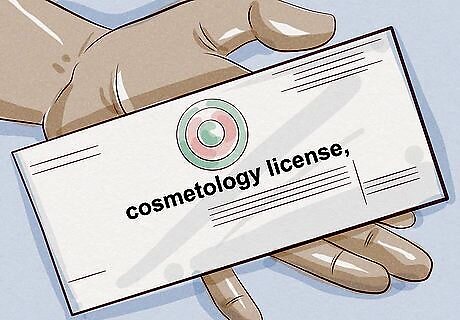
Obtain licenses, permits, and insurance required by your city, state, or province. Your requirements depend on your location, so check your local government website for information about business licenses and insurance. Additionally, you might need a cosmetology license or licenses to perform other services, such as nails or hair removal. It typically takes between 9 and 12 months to complete a cosmetology program. Specialist programs, such as nails, usually take 6 months. Other requirements might include a business owner's insurance policy (which covers general liability and commercial property), general business license, home occupation permit, sign permit, and health and safety permits. Search online for “cosmetology board” and your state or province. Your local board’s website will provide information about how to legally operate a home salon.

Renovate the space to meet local codes, if necessary. Depending on your home’s existing layout, you might need to make adjustments to meet local codes. Many jurisdictions require a permanent wall between the salon and the part of the house where you live. Additionally, the salon might need a separate entrance and public restroom. You could apply for a business loan from your bank, open a line of credit, or find a silent partner to finance renovations and other opening expenses. If you don’t own your home, you’ll need to get permission to operate a business and make any necessary renovations from your landlord.

Set up a wet station. A wet station is a large ceramic sink for shampooing and conditioning clients' hair. Some customers expect a wash to be included with a cut, and access to water is essential if you offer additional services, such as coloring. While an ordinary sink or tub might work, you’ll have a better shot at gaining customer loyalty if you have a professional salon sink.

Decorate and furnish the space. Your salon should reflect your tastes and create a soothing, comfortable atmosphere. Light, soft greens and blues are good wall color choices, and plants are great decorative features. Brainstorm potential looks by creating a mood board with colors, images, and design elements that inspire you. Additionally, large mirrors, comfortable chairs or a bench for reception, and shelving for equipment storage and retail display are all must-haves.
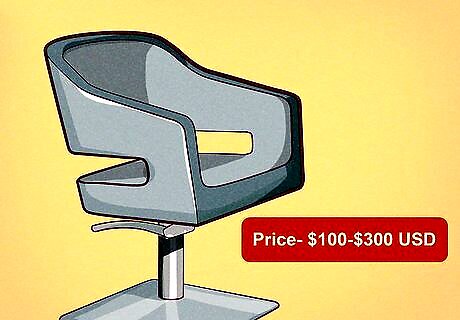
Purchase a chair, products, cutting and styling supplies, and other equipment. A salon chair is a basic requirement, and you can find one online or at a beauty supply store for $100 to $300. Purchase scissors and razors, and stock up on shampoo, conditioner, toner, hair spray, hair gel, and hair mousse. Keep in mind you’ll need to replace your product inventory regularly. Look for brand name hair products that your clients will be familiar with and trust. You can buy hair products at a beauty supply store or online. If you'll offer hair coloring and extensions, you'll need to stock up on products for these services as well.
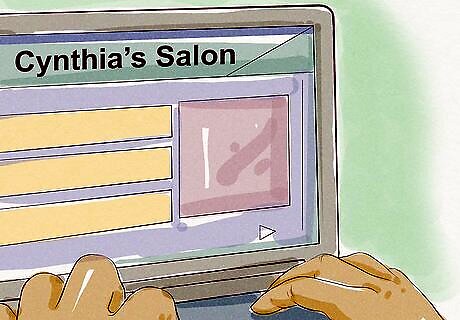
Set up a website and social media profiles. Your website should include images of your space, your address and contact information, and information about the services you offer. Instagram, Facebook, and other social media platforms allow you to promote your services with before and after pictures, hashtags, and unique or quirky statuses that reflect your personality. Update your social media profiles daily to engage your customers. When you're just starting out, ask your friends, family, and other members of your social network to like your page. With your clients’ consent, post before and after pictures on Facebook and Instagram. Encourage them to mention you on social media and to use your business’s hashtags.
Offering Great Services
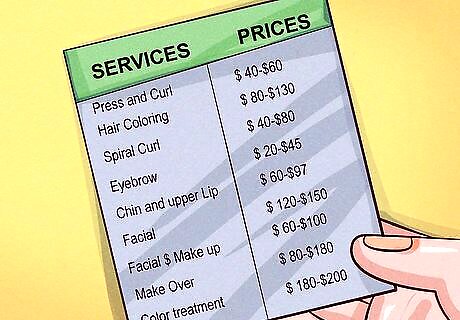
Price your services competitively. Base your prices on your overhead costs, what your competitors charge, and on your location’s median income level. Add up your operating expenses (including products, equipment, mortgage or rent, and utilities), taxes, costs to maintain permits and licenses, and any outstanding loans. Figure out how much money you need to make to cover these costs and maintain a profit margin of at least 10 to 20 percent. For example, if you want to make $52,000 per year to maintain a 15 percent profit margin, you need to make $1,000 per week. If $80 for a women’s cut and $40 for a men’s cut are reasonable prices in your area, you’ll need to book enough appointments at these rates to meet your weekly quota. While reasonable prices and discounts can build your client base, you need to charge enough to cover your overhead and generate profit. If you undersell your services or offer too many discounts, your profits could take a hit.

Offer basic services that target your local market. At a minimum, your services should include cuts, washes, and styling. High end services, such as a $200 precisely sculptured cut, work well in wealthy areas. However, you might want to focus on inexpensive basic cuts in less affluent locations. You might focus on cutting and styling a particular gender or hair type. Factor in your local customers’ needs and, if necessary, broaden your skills so you can build a larger customer base.

Include coloring and extensions to broaden your clientele. Hair coloring and extensions can add variety and help you book more appointments. You’ll need to maintain an inventory of all necessary materials, which you can purchase at beauty supply stores. Keep in mind that your local jurisdiction might regulate the use of chemicals or require additional permits. For instance, in the UK, hairdressers must administer a patch allergy test before coloring a client’s hair.

Offer additional services, such as facials, make up styling, and hair removal. Additional services allow clients to patronize your business in between cuts, giving you more opportunities to make money. If necessary, invest in a class to develop these skills yourself or hire staff to help you provide these services. You may start with basic services first, then see if adding other services like facials, make up, and waxing make sense for your home business. They may be good options if you are not getting as many hair clients as you’d like or if you’d like to try out different skills on your clients.

Display and sell retail products. Retail is a quick and easy way to generate revenue. A business license allows you to purchase products from wholesalers, which you can then sell at a marked up price. Most retailers use a 50 percent markup. If you purchased a product wholesale at $7, sell it for $14.
Growing Your Business
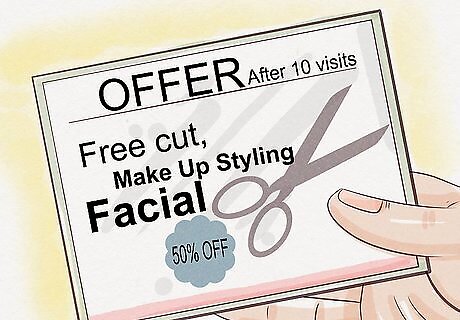
Offer a rewards program to attract loyal customers. Hand out punch cards that offer a free cut, make up styling, or facial after 10 visits. You could also offer clients points for every dollar they spend. Be sure to tell your customers about your rewards program the first time they visit. If you use a POS (point of sale) program, it might have the ability to track how much individual customers spend. If not, you could create a quick spreadsheet that tracks customer spending. List customers in the first column, enter their purchases into the next columns, and total their spending in the last column. Offer a perk when they reach a milestone, such 10 percent off their next cut when they spend $100.

Create a customer referral program. Word of mouth is the primary way most small businesses grow their customer base. Offer clients a one-time discount if they refer a friend, family member, or coworker to your salon.
Ask your customers to share your business card. Give 2 or 3 business cards with your contact info to your satisfied customers. Ask them to give a card or your phone number to their friends. Make the exchange memorable by adding a personal touch. For instance, suppose your business card lists your salon's landline phone number. If you're comfortable using your cell phone for work, hand write your cell phone number on the card. Your customer will feel like a VIP and will be more likely to remember receiving your card.

Join a professional organization for salon owners. Search online for “professional beauty association” in your city, state, or province. Becoming a member can offer access to professional development, guidance, support, and allows owners to feel more comfortable knowing that there are other owners just like them. You can also network and meet other salon owners through these organizations. Some professional organizations charge a fee upfront or on a yearly basis to join. For Professional Beauty Association, the largest professional organization, emerging business membership fees are $175 per year. The emerging business membership level is recommended for companies with 1 to 5 employees and gross annual sales less than $100,000.

Add chairs and shampoo stations as your customer base grows. Once you start to max out your space’s income potential, expand your equipment to accommodate more appointments. With multiple stations, for instance, you could complete a men’s cut or other quick job while another client’s texture or coloring treatment sets. When you expand your space, you should also start thinking about hiring additional staff.

Hire employees or rent out chairs. Depending on your volume, you could hire someone to handle specific jobs, such as facials and waxing, or add a full-time employee who can perform all services. You could also rent out a chair, which is when a hairdresser with their own client base pays you to use your space. If you hire employees, you’ll need to pay them an hourly wage or a commission, file tax and identification paperwork, purchase additional liability insurance, and meet other national and local requirements. If you rent out a chair, you’ll just need to set up a contract with your lessee.




















Comments
0 comment